

This article needs additional citations for verification. Please help improve this articlebyadding citations to reliable sources. Unsourced material may be challenged and removed.
Find sources: "Presidium of the Supreme Soviet" – news · newspapers · books · scholar · JSTOR (November 2022) (Learn how and when to remove this message) |
Presidium of the Supreme Soviet
Президиум Верховного Совета
| |
|---|---|
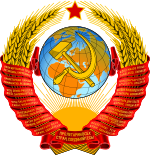 | |
| Type | |
| Type | |
| History | |
| Established | 17 January 1938 (1938-01-17) |
| Disbanded | 25 May 1989 (1989-05-25) |
| Preceded by | Central Executive Committee of the Soviet Union |
| Succeeded by | President of the Soviet Union (as head of state) |
| Seats | 39 |
| Elections | |
| Election by joint session of both houses of the Supreme Soviet | |
| Meeting place | |
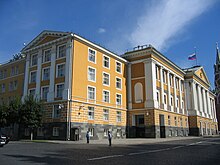 | |
| Kremlin Presidium, Moscow Kremlin 55°45′08″N 37°37′12″E / 55.7523°N 37.6200°E / 55.7523; 37.6200 | |
| Politics of the Soviet Union |
|---|
 |
|
Leadership |
|
Legislature |
|
Governance |
|
Judiciary |
|
Society |
|
|
|
|

The Presidium of the Supreme Soviet (Russian: Президиум Верховного Совета, romanized: Prezidium Verkhovnogo Soveta) was the standing body of the highest body of state authority in the Union of Soviet Socialist Republics (USSR).[1] The presidium was elected by joint session of both houses of the Supreme Soviet to act on its behalf while the Supreme Soviet was not in session. By the 1936 and 1977 Soviet Constitution, the Presidium of the Supreme Soviet served as the collective head of state of the USSR.[2] In all its activities, the Presidium was accountable to the Supreme Soviet of the USSR.[1]
Beside the all-Union body they were also in all union republics (e.g.: Presidium of the Supreme Soviet of the Russian SFSR, Presidium of the Ukrainian SSR, etc.) and other regions including autonomous republics. Structure and functions of the presidiums in these republics were virtually identical.[3]
During discussions in regard to the adoption of the 1936 Constitution of the Soviet Union, on proposition to elect the chairman of the Presidium in a nationwide election, Stalin argued:
According to the system of our Constitution, there must not be an individual President in the U.S.S.R., elected by the whole population on a par with the Supreme Soviet and able to put himself in opposition to the Supreme Soviet. The President of the U.S.S.R. is a collegium, it is the Presidium of the Supreme Soviet, including the President of the Presidium of the Supreme Soviet, elected, not by the whole population but by the Supreme Soviet and accountable to the Supreme Soviet. Historical experience shows that such a structure of the supreme bodies is the most democratic and safeguards the country against undesirable contingencies."[4]
The Presidium of the Supreme Soviet was elected by the Supreme Soviet of the USSR at a joint session of both chambers at the first session of each after convocation. The deputies of the Presidium were appointed for the duration of the term of office of the Supreme Soviet. The Presidium of the Supreme Soviet of the USSR consisted of a chairman, a first vice-chairman (after 1977), his 15 deputies (one from each republic), a secretary, and 20 additional deputies from its two constituent chambers, for a total of 39. The Presidium was accountable to the Supreme Soviet of the USSR for all its activities.
From 1938 to 1989, the chairman of the Presidium was reckoned as the USSR/Soviet Union's head of state and was sometimes referred to as the "President of the USSR/Soviet Union" in non-Soviet sources.[5]
Its building, situated inside the Moscow Kremlin, was appropriately named the Kremlin Presidium.
According to the 1936 Constitution of the USSR, as in force as enacted originally (and thus, at the establishment of the Presidium), the basic powers of the Presidium of the Supreme Soviet of the USSR were:
The presidium also dealt with questions regarding the acquisition of the Soviet citizenship, its forfeiting or voluntary rejection.
When the Supreme Soviet was not in session, the Presidium carried out the Supreme Soviet's ordinary functions. It was also empowered to issue decrees in lieu of law, which were to be submitted to the Supreme Soviet at its next session. If such decrees were not ratified by the Supreme Soviet, they were to be considered revoked. In practice, the Supreme Soviet's infrequent sessions (it usually sat for only one week per year) and the principles of democratic centralism meant that Presidium decrees de facto had the force of law. It was not unheard of for the CPSU Politburo to bypass the full Supreme Soviet and enact major laws as Presidium decrees. While the Supreme Soviet's power of veto was almost never exercised in practice, it was not unheard of for the Politburo to enact Presidium decrees into legislation without even the formality of submitting them to the full Supreme Soviet for ratification.[6]
As party members made up the majority of members of the presidum, in such plenary sessions or extraordinary ones wherein the Chairman of the Presidium or any high ranking CC-CPSU introduces a relevant CC decision for the resolution of the Presidium or if any decrees would be passed by it, they voted thus in the manner prescribed by the Constitution and laws to wilt that any absolute majority of deputies voting in favor thus approved the law, the same number voting not in favor (not unlike the ones as mentioned before) produced a veto on the draft legislation.
According to the 1977 Constitution of the USSR, as in force at the union's dissolution (and thus, at the abolition of the Presidium), the basic powers of the Presidium of the Supreme Soviet of the USSR were:
By then, most of the Presidium's former powers were reassigned to the whole Supreme Soviet and to the President of the USSR.
| No. [note 1] |
Name (Birth–Death) |
Portrait | Term of office | Supreme Soviet Convocations [note 2] |
|---|---|---|---|---|
| Chairman of the Presidium of the Supreme Soviet (1938–1989) | ||||
| 1 | Mikhail Kalinin (1875–1946)[7] |
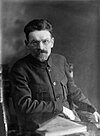
|
17 January 1938 – 19 March 1946 | 1st Convocation |
| 2 | Nikolai Shvernik (1888–1970)[8] |
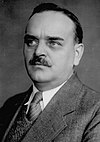
|
19 March 1946 – 15 March 1953 | 2nd–3rd Convocation |
| 3 | Kliment Voroshilov (1881–1969)[9] |

|
15 March 1953 – 7 May 1960 | 3rd–5th Convocation |
| 4 | Leonid Brezhnev (1906–1982)[10] |

|
7 May 1960 – 15 July 1964 | 5th–6th Convocation |
| 5 | Anastas Mikoyan (1895–1978)[11] |

|
15 July 1964 – 9 December 1965 | 6th Convocation |
| 6 | Nikolai Podgorny (1903–1983)[12] |
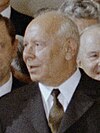
|
9 December 1965 – 16 June 1977 | 6th–9th Convocation |
| (4) | Leonid Brezhnev (1906–1982)[10] |

|
16 June 1977 – 10 November 1982 | 9th–10th Convocation |
| — | Vasily Kuznetsov (1901–1990)[13] |

|
10 November 1982 – 16 June 1983 | 10th Convocation |
| 7 | Yuri Andropov (1914–1984)[14] |

|
16 June 1983 – 9 February 1984 | |
| — | Vasily Kuznetsov (1901–1990)[13] |

|
9 February 1984 – 11 April 1984 | |
| 8 | Konstantin Chernenko (1911–1985)[14] |

|
11 April 1984 – 10 March 1985 | 11th Convocation |
| — | Vasily Kuznetsov (1901–1990)[13] |

|
10 March 1985 – 27 July 1985 | |
| 9 | Andrei Gromyko (1909–1989)[15] |

|
27 July 1985 – 1 October 1988 | |
| 10 | Mikhail Gorbachev (1931–2022)[16] |
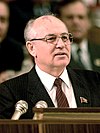
|
1 October 1988 – 25 May 1989 | 11th–12th Convocation |
| Chairman of the Supreme Soviet (1989–1990)[note 3] | ||||
| Mikhail Gorbachev (1931–2022)[16] |

|
25 May 1989 – 15 March 1990 | 12th Convocation | |
| 11 | Anatoly Lukyanov (1930–2019)[18] |

|
15 March 1990 – 4 September 1991 | 12th Convocation |
| No. [note 1] |
Name (Birth–Death) |
Portrait | Term of office | Convocations [note 2] |
|---|---|---|---|---|
| First Vice Chairman of the Presidium of the Supreme Soviet
(1944–1946) (1977–1989) | ||||
| 1 | Nikolai Shvernik
(1888–1970) |

|
4 March 1944 – 25 June 1946 | 1st Conversation |
| 2 | Vasily Kuznetsov
(1901–1990)[13] |

|
7 October 1977 – 18 June 1986 | 9th–11th Convocation |
| 3 | Pyotr Demichev (1917–2010)[19] |

|
18 June 1986 – 1 October 1988 | 11th Convocation |
| 4 | Anatoly Lukyanov (1930–2019)[18] |

|
1 October 1988 – 25 May 1989 | 11th–12th Convocation |
| Vice Chairman of the Supreme Soviet (1989–1990) | ||||
| Anatoly Lukyanov (1930–2019)[18] |

|
25 May 1989 – 15 March 1990 | 12th Convocation | |
| International |
|
|---|---|
| National |
|
| Other |
|